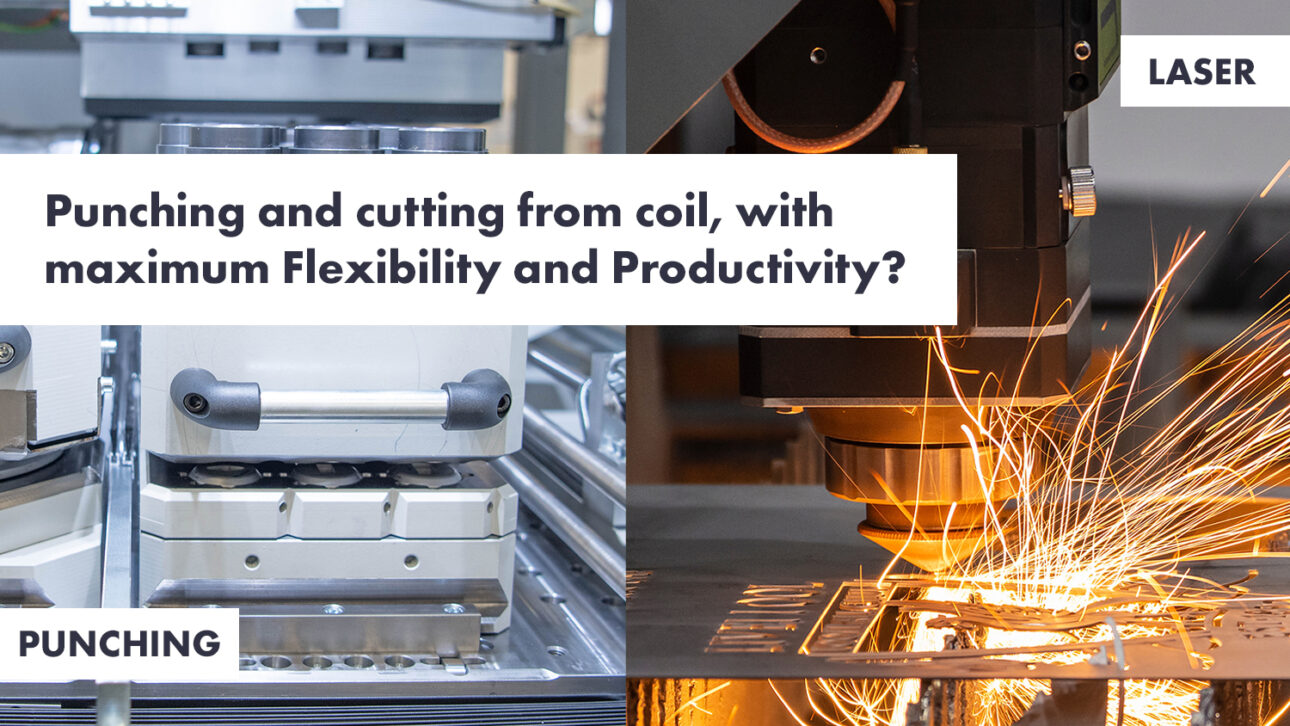Punching and cutting from coil, with maximum Flexibility and Productivity?
This is how the world’s first coil punching/laser combo was born

In 2013, we decided to consolidate our various companies into one, Dallan, through mergers by incorporation.
So, following the acquisition of the minority stakeholders’ shares, we managed to complete the whole business within the space of six months.
That year I was appointed CEO and we embarked upon a profound reorganization.
My wife Nadia was head of personnel at Elco-Ecoflam, a company that’s part of the Ariston Thermo Group.
Taken from the book «The Revolution of Efficiency«
At the time, we had a hundred and fifty people in total from the six different companies and I remember the evening I asked Nadia to come and help me by bringing her management skills as head of personnel to Dallan.
She only thought about it for a few minutes: she realized the importance I placed on having her in that role and the opportunity she had of helping me by improving the function and finally managing it in a professional manner. She’s now been by my side for seven years and I’ll always be grateful to her.
A period of very hard work commenced for my team. I could also count on Andrea Barbon, our company’s financial director for twenty years, as well as a friend of mine since I was six years old.
We introduced the role of Project Manager in 2014. A year later, my sister Lucia, who was a management engineer with almost six years of experience as a consultant in business organization at Accenture, accepted my invitation to join the company in this role.
Today, we have four management engineers who work as project managers, managing customer projects and the company’s continuous improvement projects.
As soon as the mergers were completed, in April 2013 we decided to invest in the development of a new coil-fed laser cutting machine, which added flexibility to the efficiency and productivity of our punching machines.
It was imperative that we unveil it in October 2014, at the premiere international fair, the Euroblech in Hanover: it was the first combined punching and laser line in the world.
During those years, the fiber laser had firmly established itself as a reliable and simpler solution than CO2 laser systems. We wanted a system that was different from what was already on the market.
The problems with existing coil -fed lasers
The coil-fed lasers that were already on the market have two major problems:
- They use a roller feeder to move the sheet metal forwards and backwards continuously, trying to coordinate the movement with that of the head moving in the Y axis;
- Or, they process very narrow portions of coil, one step at a time.
All this movement and repositioning makes it extremely difficult to produce pieces within acceptable tolerances – even more so in the case of lengthy pieces.
Furthermore, they rely on runners to correctly position the transversal cut and this represents a problem, in particular, if the coils are not perfect or if the runners are not perfectly positioned.
Other coil-fed laser systems have a wider processing range, but move the sheet metal during cutting and without runners for the coil: guaranteeing precision is clearly quite a challenge!
The Coil To Laser solution
I called one of our software engineers, Andrea, and explained the project I had in mind. I had already spoken to a few laser technicians, who confirmed that modern technologies, the support of IPG and a skilled software engineer – combined with a lot of commitment and dedication – would mean that the first prototype could be completed in time for the fair.
In the period that followed, we focused on developing lots of technologies and solutions that we immediately patented.
In the end, we did it. The prototype was built on time and we unveiled it at the Euroblech fair in 2014, where it was greeted with curiosity – being the only machine of its kind at the fair, visitors naturally had numerous questions that we had to learn how to answer.
However, the first prototype had a problem, which at first appeared difficult to solve. A combined machine normally performs one operation at a time: it either punches or cuts with the laser.
Furthermore, it wasn’t easy to insert runners on the laser table and the characteristics and tolerances of the coils meant we could not rely on runners to position the laser beam on the Y axis. So, we decided to set to work on a completely new line: a combined one with simultaneous punching and laser cutting.
Firstly, we completely eliminated the runners for the laser, using a vision system on the laser head that was able to identify the actual position of the sheet and the reference holes. Then, we completely separated the punching machine and the laser, inserting an intermediate roller conveyor.
That allowed us to achieve two important results.
The first was that the laser and the punching machine could work independently and simultaneously. By intelligently combining punching and laser cutting operations, we were able to reduce processing times by more than 30 percent compared to the faster combined sheet-fed punching machines and, for some products, being even twice as fast.
The second major result was allowing our laser, even the non-combined version, to work while repositioning multiple times. Even pieces that were14-meters in length – something that no sheet-fed laser could achieve.
The absence of runners and the addition of the vision system, which we patented, represent major strengths that make our machines stand out, even now!
Thanks to the addition of a laser system, the coil-fed punching machine achieved the same flexibility as a sheet-fed punching machine, with the added convenience of continuous and automatic processing: very high productivity and very high efficiency.
The first combined machine was installed in 2016 at a company called Elleci in Pordenone, which we can see in this documentary:
The company produces high quality electrical panels and carpentries for the electromechanical sector.
They had already been our customers for over twenty years and have had a hydraulic Dalcos punching machine, which is still operational, since 2004. They had seen the machine at the fair in Hannover and the owner, Mr. Corazza, visited us at the beginning of 2015.
Elleci already used combined sheet-fed systems and coil-fed punching systems, they sensed the potential of the system and – like Giovanni a few years earlier – selected a set of products that, in terms of lot sizes and flexibility, could be comfortably inserted in a coil-fed combined system.
They had two main problems.
The first was excessive material waste. The panels being produced had complex geometries, they required nesting in standard format sheets – in which case they had to accept 16 percent waste, or in special format sheets – in which case they had to increase stock for the various special formats.
Furthermore, the complexity and geometry of these panels meant they could only be produced using a combined line.
The sheet-fed line required either an investment in automation or the continuous presence of an operator. In addition, the combined sheet-fed punching machines they had, like all machines of that type, performed only one operation at a time: they either punched or cut using a laser. Consequently, they were slower and had very high hourly operating costs.
This also taught me a lot about the benefits that our technology offered. Elleci had grasped two important concepts.
The first, which they learned from their first coil-fed punching machine, was that it was possible to virtually eliminate material waste for those specific products.
The second was that our machine, which was automatic, had lower operating costs and, moreover, completed production faster.
Engineer Giorgio Tomasella, director of Elleci, conducted an analysis on the cash flow that the line had to generate in terms of material savings in production (efficiency) and in terms of less hours worked (productivity) and lower hourly cost of the system.
The result was a famous case study that I often use to explain our method and that I’ll illustrate at the end of this book.
Giorgio Tomasella calculated the total cost of annual production for the products he had to make for each of the two technologies. He then compared the total cost of the raw material that he would need to purchase using a sheet-fed system with the total cost of the raw material using a coil-fed system.
The result was an overall saving of 97 thousand Euros per year, with the coil-fed machine operating on two shifts. Hence, the point in terms of efficiency.
Next, he compared the cost of the hours worked, keeping in mind the working time for a standard combined sheet-fed line and for our combined coil-fed line.
The result was a time saving of 2,266 hours per year, which is than one shift. Calculating just the cost of electricity and personnel, Elleci achieved savings of over 100,000 Euros per year. In addition to the fact that the combined coil-fed punching machine completed the work by itself, while two combined sheet-fed machines would be needed to complete all their production.
Hence, we see the key concept of Productivity once more.
Adding the flexibility of a laser made it possible to exploit the productivity and efficiency of the combined line to the full, generating a positive cash flow of almost 200,000 Euros per year compared to a traditional system.
Having such powerful technology in the company was a fundamental asset for Elleci. They had the vision and courage to be pioneers of this new processing technology and have enjoyed the benefits that come with being the first in their category to do so for years.

Andrea Dallan
CEO – Dallan Spa
